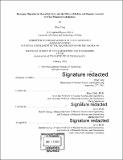| dc.contributor.advisor | Bilge Yildiz and Ju Li. | en_US |
| dc.contributor.author | Yang, Ming, S.M. Massachusetts Institute of Technology | en_US |
| dc.contributor.other | Massachusetts Institute of Technology. Department of Nuclear Science and Engineering. | en_US |
| dc.date.accessioned | 2018-08-22T14:28:28Z | |
| dc.date.available | 2018-08-22T14:28:28Z | |
| dc.date.copyright | 2016 | en_US |
| dc.date.issued | 2016 | en_US |
| dc.identifier.uri | http://hdl.handle.net/1721.1/117451 | |
| dc.description | Thesis: S.M., Massachusetts Institute of Technology, Department of Nuclear Science and Engineering, 2016. | en_US |
| dc.description | Cataloged from student-submitted PDF version of thesis. | en_US |
| dc.description | Includes bibliographical references (pages 80-82). | en_US |
| dc.description.abstract | Zirconium-based alloys, which have been employed as cladding materials in nuclear industry, pick up hydrogen during service because of corrosion in water. This is one of the degradation processes that challenge the safe operation of nuclear reactors. Composition of commercial zirconium-based alloys has been developed experimentally, aiming to improve corrosion and hydrogen resistance. The empirical testing process is costly, time-consuming and can provide little knowledge on the underlying mechanisms. In order to understand the critical step of hydrogen entering zirconium-based alloys, we study hydrogen migration in monoclinic zirconium dioxide (m-ZrO2 ), the oxide phase, which is present in the outer protective oxide layer contacting the cooling water. First principles calculations are casted to study hydrogen migration at atom-istic scale. All possible stable sites for hydrogen to take in the structure are determined based on energy minimization. Barriers and saddle point configurations of elemental diffusion paths are obtained using the nudged elastic band method. Each extended diffusion path can be constructed from these elemental migration steps ... | en_US |
| dc.description.statementofresponsibility | by Ming Yang. | en_US |
| dc.format.extent | 82 pages | en_US |
| dc.language.iso | eng | en_US |
| dc.publisher | Massachusetts Institute of Technology | en_US |
| dc.rights | MIT theses are protected by copyright. They may be viewed, downloaded, or printed from this source but further reproduction or distribution in any format is prohibited without written permission. | en_US |
| dc.rights.uri | http://dspace.mit.edu/handle/1721.1/7582 | en_US |
| dc.subject | Nuclear Science and Engineering. | en_US |
| dc.title | Hydrogen migration in monoclinic ZrO₂ and the effects of defects and dopants assessed by first-principles calculations | en_US |
| dc.title.alternative | Hydrogen migration in monoclinic zirconium dioxide and the effects of defects and dopants assessed by first-principles calculations | en_US |
| dc.type | Thesis | en_US |
| dc.description.degree | S.M. | en_US |
| dc.contributor.department | Massachusetts Institute of Technology. Department of Nuclear Science and Engineering | |
| dc.identifier.oclc | 1048403620 | en_US |
